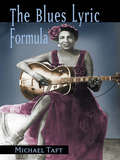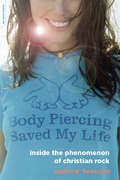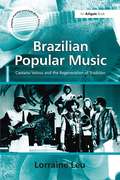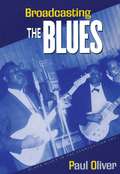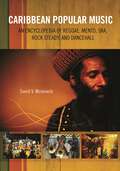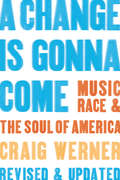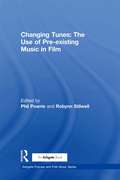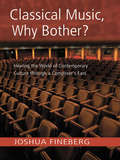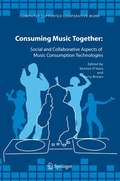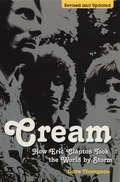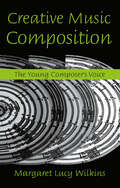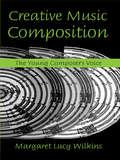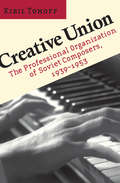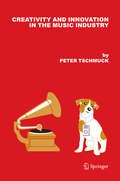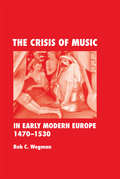- Table View
- List View
The Blues Lyric Formula
by Michael TaftThis book is the first rigourous and detailed exploration of exactly how blues singers used formulas to create songs, and it more than amply fills the gap in the the study of the blues, where the structure and content of the lyrics have been less fully explored than the musical form. Focusing on the songs recorded by African-American singers for pre-World War Two commercial recording companies, this is an excellent structural analysis of the formulaic composistion of blues lyrics. This book gives a step-by-step description of the rules implicit in this formulaic structure and inspires new discussion of lyric structures. A wide array of readers will find this insightful and informative: from students of African-American music, cultural studies, history and linguistics, to Blues fans fascinated by exactly how the lyrics of this influential music style are written.
Bob Dylan's Highway 61 Revisited (33 1/3)
by Mark PolizzottiHighway 61 Revisited resonates because of its enduring emotional appeal. Few songwriters before Dylan or since have combined so effectively the intensely personal with the spectacularly universal. In "Like a Rolling Stone," his gleeful excoriation of Miss Lonely (Edie Sedgwick? Joan Baez? a composite "type"?) fuses with the evocation of a hip new zeitgeist to produce a veritable anthem. In "Ballad of a Thin Man," the younger generation's confusion is thrown back in the Establishment's face, even as Dylan vents his disgust with the critics who labored to catalogue him. And in "Desolation Row," he reaches the zenith of his own brand of surrealist paranoia, that here attains the atmospheric intensity of a full-fledged nightmare. Between its many flourishes of gallows humor, this is one of the most immaculately frightful songs ever recorded, with its relentless imagery of communal executions, its parade of fallen giants and triumphant local losers, its epic length and even the mournful sweetness of Bloomfield's flamenco-inspired fills. In this book, Mark Polizzotti examines just what makes the songs on Highway 61 Revisited so affecting, how they work together as a suite, and how lyrics, melody, and arrangements combine to create an unusually potent mix. He blends musical and literary analysis of the songs themselves, biography (where appropriate) and recording information (where helpful). And he focuses on Dylan's mythic presence in the mid-60s, when he emerged from his proletarian incarnation to become the American Rimbaud. The comparison has been made by others, including Dylan, and it illuminates much about his mid-sixties career, for in many respects Highway 61 is rock 'n' roll's answer to A Season in Hell.
Body Piercing Saved My Life: Inside the Phenomenon of Christian Rock
by Andrew BeaujonBody Piercing Saved My Life is the first in-depth journalistic investigation into a subculture so large that it's erroneous to even call it a subculture: Christian rock. Christian rock culture is booming, not only with bands but with extreme teen Bibles, skateboarding ministries, Christian tattoo parlors, paintball parks, coffeehouses, and nightclubs,encouraging kids to form their own communities apart from the mainstream. Profiling such successful Christian rock bands as P.O.D., Switchfoot, Creed, Evanescence, and Sixpence None the Richer, as well as the phenomenally successful Seattle Christian record label Tooth & Nail, enormous Christian rock festivals, and more, Spin journalist Andrew Beaujon lifts the veil on a thriving scene that operates beneath the secular world's radar. Revealing, sympathetic, and groundbreaking, Body Piercing Saved My Life (named for a popular Christian rock T-shirt depicting Christ's wounds) is a fascinating look into the hearts and minds of an enormous, and growing, youth culture.
Body Piercing Saved My Life: Inside the Phenomenon of Christian Rock
by Andrew BeaujonBody Piercing Saved My Life is the first in-depth journalistic investigation into a subculture so large that it's erroneous to even call it a subculture: Christian rock. Christian rock culture is booming, not only with bands but with extreme teen Bibles, skateboarding ministries, Christian tattoo parlors, paintball parks, coffeehouses, and nightclubs,encouraging kids to form their own communities apart from the mainstream. Profiling such successful Christian rock bands as P.O.D., Switchfoot, Creed, Evanescence, and Sixpence None the Richer, as well as the phenomenally successful Seattle Christian record label Tooth & Nail, enormous Christian rock festivals, and more, Spin journalist Andrew Beaujon lifts the veil on a thriving scene that operates beneath the secular world's radar. Revealing, sympathetic, and groundbreaking, Body Piercing Saved My Life (named for a popular Christian rock T-shirt depicting Christ's wounds) is a fascinating look into the hearts and minds of an enormous, and growing, youth culture.
Brazilian Popular Music: Caetano Veloso and the Regeneration of Tradition
by Lorraine LeuBrazilian Popular Music, or M‘sica Popular Brasileira (MPB), developed in the mid 1960s as a response to the re-thinking of Brazilian national identity following the establishment of the post-1964 military regime. A leading figure in MPB at this time was Caetano Veloso, and it is his music and its reception that form the focus of this book. A leader of the Tropicalist movement, Veloso sought to initiate a critical debate on Brazilian Popular Music and the political and ideological foundations which underpinned its aesthetic. Lorraine Leu examines Veloso's musical and vocal styles, revealing the ways in which they play with traditional expectations between the performer and listener, and argues that they represent an important response to the severe censorship and repression of the military regime.
Brazilian Popular Music: Caetano Veloso and the Regeneration of Tradition
by Lorraine LeuBrazilian Popular Music, or M‘sica Popular Brasileira (MPB), developed in the mid 1960s as a response to the re-thinking of Brazilian national identity following the establishment of the post-1964 military regime. A leading figure in MPB at this time was Caetano Veloso, and it is his music and its reception that form the focus of this book. A leader of the Tropicalist movement, Veloso sought to initiate a critical debate on Brazilian Popular Music and the political and ideological foundations which underpinned its aesthetic. Lorraine Leu examines Veloso's musical and vocal styles, revealing the ways in which they play with traditional expectations between the performer and listener, and argues that they represent an important response to the severe censorship and repression of the military regime.
Broadcasting the Blues: Black Blues in the Segregation Era
by Paul OliverBroadcasting the Blues: Black Blues in the Segregation Era is based on Paul Oliver's award-winning radio broadcasts from the BBC that were created over several decades. It traces the social history of the blues in America, from its birth in the rural South through the heyday of sound recordings. Noted blues scholar Paul Oliver draws on decades of research and personal interviews with performers--some of whom he "discovered" and recorded for the first time--to draw a picture of how the blues aesthetic developed, giving new insights into the role blues played in American society before racial integration. The book begins by outlining the history of the blues from African music through country stomps, ragtime songs, and field hollers. From the heroic figures of black folksong--including the steel-driving railroad worker John Henry and the destructive Boll Weevil--to the content of the emerging blues, the author discusses the "meaning" behind the often coded words of the blues, evoking topics such as playful sexuality, magic and medicine, the stresses of segregation, and commentary on national events. Finally, the author traces the history of blues documentation, showing how our views of the early blues have been shaped through a complex interplay of social forces, and indicating possible lines for future research.
Broadcasting the Blues: Black Blues in the Segregation Era
by Paul OliverBroadcasting the Blues: Black Blues in the Segregation Era is based on Paul Oliver's award-winning radio broadcasts from the BBC that were created over several decades. It traces the social history of the blues in America, from its birth in the rural South through the heyday of sound recordings. Noted blues scholar Paul Oliver draws on decades of research and personal interviews with performers--some of whom he "discovered" and recorded for the first time--to draw a picture of how the blues aesthetic developed, giving new insights into the role blues played in American society before racial integration. The book begins by outlining the history of the blues from African music through country stomps, ragtime songs, and field hollers. From the heroic figures of black folksong--including the steel-driving railroad worker John Henry and the destructive Boll Weevil--to the content of the emerging blues, the author discusses the "meaning" behind the often coded words of the blues, evoking topics such as playful sexuality, magic and medicine, the stresses of segregation, and commentary on national events. Finally, the author traces the history of blues documentation, showing how our views of the early blues have been shaped through a complex interplay of social forces, and indicating possible lines for future research.
Caribbean Popular Music: An Encyclopedia of Reggae, Mento, Ska, Rock Steady, and Dancehall (Non-ser.)
by David V. MoskowitzReggae music is more than just steel drum bands on white sand beaches. Its history is rich with culture and evolution, helping to tell the story of Jamaica's past. Due to its depth and extensive coverage, this book is the most complete and up to date encyclopedia about reggae, mento, ska, rocksteady, and dancehall music on the market today. Ideal for reggae lovers and college students studying music, this encyclopedia is comprehensive for high school students and non-music students as well. From Bob Marley to Wayne Wonder, this easy to use encyclopedia contains over 700 entries. Indices in both the front and back of the book make navigating through entries extremely user-friendly.Entries cover singers and songwriters, producers, record labels, and different styles of music that evolved from reggae. Moskowitz truly captures the history and evolution of Jamaican music in this extensive, illuminating encyclopedia, while all the while making it accessible to both high school and college students.
A Change Is Gonna Come: Music, Race & the Soul of America
by Craig Werner". . . extraordinarily far-reaching. . . . highly accessible." —Notes "No one has written this way about music in a long, long time. Lucid, insightful, with real spiritual, political, intellectual, and emotional grasp of the whole picture. A book about why music matters, and how, and to whom." —Dave Marsh, author of Louie, Louie and Born to Run: The Bruce Springsteen Story "This book is urgently needed: a comprehensive look at the various forms of black popular music, both as music and as seen in a larger social context. No one can do this better than Craig Werner." —Henry Louis Gates, Jr., W.E.B. Du Bois Professor of the Humanities, Harvard University "[Werner has] mastered the extremely difficult art of writing about music as both an aesthetic and social force that conveys, implies, symbolizes, and represents ideas as well as emotion, but without reducing its complexities and ambiguities to merely didactic categories." —African American Review A Change Is Gonna Come is the story of more than four decades of enormously influential black music, from the hopeful, angry refrains of the Freedom movement, to the slick pop of Motown; from the disco inferno to the Million Man March; from Woodstock's "Summer of Love" to the war in Vietnam and the race riots that inspired Marvin Gaye to write "What's Going On." Originally published in 1998, A Change Is Gonna Come drew the attention of scholars and general readers alike. This new edition, featuring four new and updated chapters, will reintroduce Werner's seminal study of black music to a new generation of readers. Craig Werner is Professor of Afro-American Studies at the University of Wisconsin, and author of many books, including Playing the Changes: From Afro-Modernism to the Jazz Impulse and Up Around the Bend: An Oral History of Creedence Clearwater Revival. His most recent book is Higher Ground: Stevie Wonder, Aretha Franklin, Curtis Mayfield, and the Rise and Fall of American Soul.
Changing Tunes: The Use of Pre-existing Music in Film
by Robynn StilwellThe study of pre-existing film music is now a well-established part of Film Studies, covering 'classical' music and popular music. Generally, these broad musical types are studied in isolation. This anthology brings them together in twelve focused case studies by a range of scholars, including Claudia Gorbman, Jeongwon Joe, Raymond Knapp, and Timothy Warner. The first section explores art music, both instrumental and operatic; it revolves around the debate on the relation between the aural and visual tracks, and whether pre-existing music has an integrative function or not. The second section is devoted to popular music in film, and shows how very similar the functions of popular music in film are to the supposedly more 'elite' classical music and opera. Case studies in part 1: Eyes Wide Shut, Raging Bull, Brief Encounter, Detective, The Godfather Part III, three versions of the Carmen story (DeMille's, Preminger's and Rosi's), Amadeus, The Birth of a Nation, M: Eine Stadt sucht einen MA rder, Needful Things, Rat Race. Case studies in part 2: various films by AlmodA^3var, Young Frankenstein, Pulp Fiction, Trainspotting, Amelie, High Fidelity, Ghost World, Heavenly Creatures, The Virgin Suicides, and the video Timber by Coldcut.
Changing Tunes: The Use of Pre-existing Music in Film
by Robynn StilwellThe study of pre-existing film music is now a well-established part of Film Studies, covering 'classical' music and popular music. Generally, these broad musical types are studied in isolation. This anthology brings them together in twelve focused case studies by a range of scholars, including Claudia Gorbman, Jeongwon Joe, Raymond Knapp, and Timothy Warner. The first section explores art music, both instrumental and operatic; it revolves around the debate on the relation between the aural and visual tracks, and whether pre-existing music has an integrative function or not. The second section is devoted to popular music in film, and shows how very similar the functions of popular music in film are to the supposedly more 'elite' classical music and opera. Case studies in part 1: Eyes Wide Shut, Raging Bull, Brief Encounter, Detective, The Godfather Part III, three versions of the Carmen story (DeMille's, Preminger's and Rosi's), Amadeus, The Birth of a Nation, M: Eine Stadt sucht einen MA rder, Needful Things, Rat Race. Case studies in part 2: various films by AlmodA^3var, Young Frankenstein, Pulp Fiction, Trainspotting, Amelie, High Fidelity, Ghost World, Heavenly Creatures, The Virgin Suicides, and the video Timber by Coldcut.
Classical Music, Why Bother?: Hearing the World of Contemporary Culture Through a Composer's Ears
by Joshua FinebergFirst published in 2006. Routledge is an imprint of Taylor & Francis, an informa company.
Classical Music, Why Bother?: Hearing the World of Contemporary Culture Through a Composer's Ears
by Joshua FinebergFirst published in 2006. Routledge is an imprint of Taylor & Francis, an informa company.
Consuming Music Together: Social and Collaborative Aspects of Music Consumption Technologies (Computer Supported Cooperative Work #35)
by Barry Brown Kenton O'HaraListening to, buying and sharing music is an immensely important part of everyday life. Yet recent technological developments are increasingly changing how we use and consume music. This book collects together the most recent studies of music consumption, and new developments in music technology. It combines the perspectives of both social scientists and technology designers, uncovering how new music technologies are actually being used, along with discussions of new music technologies still in development. With a specific focus on the social nature of music, the book breaks new ground in bringing together discussions of both the social and technological aspects of music use. Chapters cover topics such as the use of the iPod, music technologies which encourage social interaction in public places, and music sharing on the internet. A valuable collection for anyone concerned with the future of music technology, this book will be of particular interest to those designing new music technologies, those working in the music industry, along with students of music and new technology.
Cream: How Eric Clapton Took The World By Storm
by Dave ThompsonDave Thompson, author of Virgin's acclaimed Red Hot Chili Peppers biography, takes a new and very detailed look at the creation of one of the world's most influential bands. After all the streets of London had been covered in 'Clapton Is God' tributes, the three top rock instrumentalists of their time, all stars in their own right, came together to form Cream. Cream went on to become the first band to break openthe lucrative US market by dint of their live shows alone. Updated to include details of their recent tour, this definitive account goes on the road with them then and now, day by relentlessly hedonistic day.
Creative Music Composition: The Young Composer's Voice
by Margaret Lucy WilkinsCreative Music Composition is designed to be an introductory textbook for music students. "Creative composition"-composing in your own style, rather than in the style of a composer of the past-is embraced by music educators not only for composition students, but for beginning performers and music educators, and is often offered to all music students and non-music majors who wish to enhance their musical creativity. With 25 years of experience teaching fledgling composers, the author tackles the key ingredients that make for successful composition, including: stimulus to the musical imagination; discussion of a variety of current musical languages; analysis of many examples from contemporary scores; technical exercises; suggestions as to how to start a composition; structures; and examinations of works from particular genres. Wilkins covers several musical languages, from folk and popular to serialism; analyses various rhythmic forms; suggests approaches for composing for a variety of instruments, from traditional to electronic ones, as well as for the human voice; addresses the nuts and bolts of score preparation; and offers career advice. For all composition students-and for music students in general-Creative Music Composition offers a clear and concise introduction that will enable them to reach their personal goals.
Creative Music Composition: The Young Composer's Voice
by Margaret Lucy WilkinsCreative Music Composition is designed to be an introductory textbook for music students. "Creative composition"-composing in your own style, rather than in the style of a composer of the past-is embraced by music educators not only for composition students, but for beginning performers and music educators, and is often offered to all music students and non-music majors who wish to enhance their musical creativity. With 25 years of experience teaching fledgling composers, the author tackles the key ingredients that make for successful composition, including: stimulus to the musical imagination; discussion of a variety of current musical languages; analysis of many examples from contemporary scores; technical exercises; suggestions as to how to start a composition; structures; and examinations of works from particular genres. Wilkins covers several musical languages, from folk and popular to serialism; analyses various rhythmic forms; suggests approaches for composing for a variety of instruments, from traditional to electronic ones, as well as for the human voice; addresses the nuts and bolts of score preparation; and offers career advice. For all composition students-and for music students in general-Creative Music Composition offers a clear and concise introduction that will enable them to reach their personal goals.
Creative Union: The Professional Organization of Soviet Composers, 1939–1953
by Kiril TomoffWhy did the Stalin era, a period characterized by bureaucratic control and the reign of Socialist Realism in the arts, witness such an extraordinary upsurge of musical creativity and the prominence of musicians in the cultural elite? This is one of the questions that Kiril Tomoff seeks to answer in Creative Union, the first book about any of the professional unions that dominated Soviet cultural life at the time. Drawing on hitherto untapped archives, he shows how the Union of Soviet Composers established control over the music profession and negotiated the relationship between composers and the Communist Party leadership. Central to Tomoff's argument is the institutional authority and prestige that the musical profession accrued and deployed within Soviet society, enabling musicians to withstand the postwar disciplinary campaigns that were so crippling in other artistic and literary spheres.Most accounts of Soviet musical life focus on famous individuals or the campaign against Shostakovich's Lady Macbeth and Zhdanov's postwar attack on musical formalism. Tomoff's approach, while not downplaying these notorious events, shows that the Union was able to develop and direct a musical profession that enjoyed enormous social prestige. The Union's leadership was able to use its expertise to determine the criteria of musical value with a degree of independence. Tomoff's book reveals the complex and mutable interaction of creative intelligentsia and political elite in a period hitherto characterized as one of totalitarian control.
Creativity and Innovation in the Music Industry
by Peter TschmuckThis book charts the effects of new communication technologies and the Internet on the creation of music in the early 21st century. It examines how the music industry will be altered by the Internet, music online services and MP3-technology. This is done through an integrated model based on an international history of the industry since the phonograph’s invention in 1877, and thus, the history of the music industry is described in full detail for the first time.
The Crisis of Music in Early Modern Europe, 1470-1530
by Rob C. WegmanIn the final decades of the fifteenth-century, the European musical world was shaken to its foundations by the onset of a veritable culture war on the art of polyphony. Now in paperback, The Crisis of Music in Early Modern Europe tells the story of this cultural upheaval, drawing on a wide range of little-known texts and documents, and weaving them together in a narrative that takes the reader on an eventful musical journey through early-modern Europe.
The Crisis of Music in Early Modern Europe, 1470-1530
by Rob C. WegmanIn the final decades of the fifteenth-century, the European musical world was shaken to its foundations by the onset of a veritable culture war on the art of polyphony. Now in paperback, The Crisis of Music in Early Modern Europe tells the story of this cultural upheaval, drawing on a wide range of little-known texts and documents, and weaving them together in a narrative that takes the reader on an eventful musical journey through early-modern Europe.
Da Capo Best Music Writing 2006: The Year's Finest Writing on Rock, Hip-Hop, Jazz, Pop, Country, & More (De Capo Best Music Writing Ser.)
by Mary Gaitskill Daphne CarrWhether you count yourself a member of the hip-hop nation, bang your head yearly at Ozzfest, wear a cowboy hat, or dance to the top twenty, you're sure to find something to love in Da Capo Best Music Writing 2006. Gathering a rich array of writing by music journalists, novelists, and scribes from a wide range of sources-highbrow literary quarterlies to 'zines and blogs--Da Capo Best Music Writing is a multi-voiced snapshot of the year in music writing that, like the music it illuminates, is every bit as thrilling as it is revealing.
Damage Incorporated: Metallica and the Production of Musical Identity
by Glenn Pillsbury"Damage Incorporated" is the first book about the legendary heavy metal band Metallica that provides a detailed exploration of the group’s music and its place within the wider popular music landscape. Written with a broad readership in mind, it offers an interdisciplinary study that incorporates a range of topics which intersect with the band’s music and cultural influence. For students of popular culture, mass media, and music, "Damage Incorporated" will be necessary reading, and sets a new standard for the study and exploration of metal within the field of popular music studies.
Damage Incorporated: Metallica and the Production of Musical Identity
by Glenn Pillsbury"Damage Incorporated" is the first book about the legendary heavy metal band Metallica that provides a detailed exploration of the group’s music and its place within the wider popular music landscape. Written with a broad readership in mind, it offers an interdisciplinary study that incorporates a range of topics which intersect with the band’s music and cultural influence. For students of popular culture, mass media, and music, "Damage Incorporated" will be necessary reading, and sets a new standard for the study and exploration of metal within the field of popular music studies.
